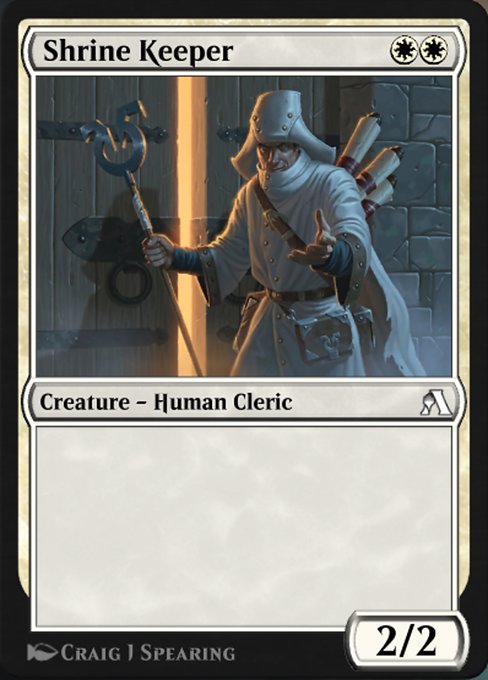
Image courtesy of Scryfall.com
Meta-aware Card Design in MTG: Shrine Keeper as a Case Study
Magic: The Gathering has always walked a tightrope between depth and accessibility. The best cards teach players the rhythm of the game while hinting at the bigger possibilities lurking in booster packs and sideboards. Shrine Keeper, a humble two-mana white creature from the Arena New Player Experience Cards (the oana set), is a perfect micro-lens to examine how meta-aware design can shape both beginners' first steps and the long tail of what strategies become viable in larger formats. At first glance, this is a tidy 2/2 Human Cleric for {W}{W}. No text, no tricksy abilities—just a solid body that rewards early board presence. Yet within that simplicity lies a deliberate design philosophy: clarity, consistency, and an invitation to explore white's broader themes 🧙♂️🔥💎.
Shrine Keeper: a quiet pillar in Arena’s beginner-friendly ecosystem
In a starter context, players are learning the basics: mana, creatures, combat, and removal. Shrine Keeper’s stat line—2 power, 2 toughness for two white mana—sits snugly on the classic mana curve curve of early-race white strategies. There’s no trick to remember, no triggered ability to track, and no mana-sink complexity to confuse a new player. This is not about fireworks; it’s about dependable performance. The card’s color identity is clear, and its role aligns with white’s long-established toolkit: efficient creatures that help stabilize the board and punish an unbalanced early assault. In the broader meta, such a card acts like a training-wheels anchor, giving players a foothold as they experiment with other white staples later on 🎨🎲.
“Sometimes the best meta-aware design is the quiet one—the card that teaches, not dazzles.”
From a gameplay-design perspective, Shrine Keeper embodies a deliberate design choice: make a starting point that’s powerful enough to feel meaningful but restrained enough to avoid creating power-spikes that scare away new players. In a digital-first environment like Arena, this translates into intuitive pick-up-and-play value. Players quickly grasp that on turn 2 they can deploy a solid blocker or early attacker, and the absence of a complicated encounter text minimizes cognitive load. The result is a card that supports experimentation with early white boards and invites players to explore how their future removals, anthem effects, and pump spells might interact with a sturdy, cost-efficient body ⚔️🧭.
Design takeaways for the future
- Learnability first: Shrine Keeper demonstrates that a card can be effective without requiring players to memorize a long oracle text. Future meta-aware designs can benefit from keeping core interactions obvious while reserving space for deeper synergies behind clearer mechanics.
- Power aligned with position: A two-drop common creature should feel like a reliable piece of the game’s fabric, not a one-card blowout. Knights of the white weft—defense, lifegain, and group buff effects—can be introduced gradually via cards that clearly state their intent and interact predictably with the board state.
- Starter-friendly rarity with long-term potential: Being a common in a starter-set environment, Shrine Keeper invites players to explore how gradually revealed mechanics (like anthem auras or life-gain synergies) can compound value as games go longer.
- Clarity over complexity: In a meta-aware design schema, ensuring text is concise helps players quickly assess a card’s role and legality. White’s identity—order, protection, and community—can be reinforced using straightforward, memorable card choices rather than opaque text boxes.
- Digital-first readability: Arena’s player base benefits from clean visuals and predictable triggers. The Shrine Keeper model shows how a card can remain relevant across formats by avoiding print-engine quirks that only exist in paper or limited printings.
Looking ahead, designers can harness the Shrine Keeper principle to craft meta-aware cards that nudge players toward the kinds of games Wizards of the Coast wants to see: lively board states on turn 3, meaningful but fair combat, and a sense of progression as decks evolve. A future white common might pair Shrine Keeper’s sturdiness with a lightLife gain or a gentle anthem aura, giving players a tangible path from early-game stability to mid-game momentum. The key is to pair clarity with strategic depth—so a card isn’t just good for a moment, but good for many games to come 🧙♂️💎.
As the community debates far-flung archetypes and the next era of set design, Shrine Keeper stands as a reminder that big ideas can begin with a little, well-balanced form. It’s a reminder that meta-awareness isn’t just about the now; it’s about shaping how players will build, learn, and iterate in the years ahead. And if you’re wiring your desk for hours of drafting, testing, or streaming, a reliable phone companion might just prove its own meta-worthy ally—hence the nod to practical accessories that keep you focused on the game 🔥🎨.
Slim Lexan Phone Case for iPhone 16More from our network
- https://wiki.digital-vault.xyz/wiki/post/pokemon-tcg-stats-umbreon-card-id-ecard3-h30/
- https://blog.crypto-articles.xyz/blog/post/nft-data-chomik-180-from-chomiks-collection-on-magiceden/
- https://crypto-acolytes.xyz/blog/post/nft-stats-agent-chammy-1676-from-agent-chammy-collection/
- https://blog.crypto-articles.xyz/blog/post/nft-data-deadly-ape-805-from-deadly-ape-collection-on-magiceden/
- https://articles.digital-vault.xyz/blog/post/early-impressions-of-braid-highlight-timed-puzzles-mechanics/

Shrine Keeper
ID: 74f04961-c42e-41fb-a770-62c7d3d2b83a
Oracle ID: c3319f74-1771-4679-bdad-0ab4b34e9106
Colors: W
Color Identity: W
Keywords:
Rarity: Common
Released: 2018-07-14
Artist: Craig J Spearing
Frame: 2015
Border: black
Set: Arena New Player Experience Cards (oana)
Collector #: 10
Legalities
- Standard — not_legal
- Future — not_legal
- Historic — legal
- Timeless — legal
- Gladiator — legal
- Pioneer — not_legal
- Modern — not_legal
- Legacy — not_legal
- Pauper — not_legal
- Vintage — not_legal
- Penny — not_legal
- Commander — not_legal
- Oathbreaker — not_legal
- Standardbrawl — not_legal
- Brawl — legal
- Alchemy — not_legal
- Paupercommander — not_legal
- Duel — not_legal
- Oldschool — not_legal
- Premodern — not_legal
- Predh — not_legal
Prices
More from our network
- https://blog.crypto-articles.xyz/blog/post/nft-data-wallet-echo-a7h-from-wallet-echoes-collection-on-magiceden/
- https://wiki.digital-vault.xyz/wiki/post/pokemon-tcg-stats-togedemaru-card-id-p-a-090/
- https://articles.digital-vault.xyz/blog/post/master-pakku-the-evolution-of-mtg-card-art-trends/
- https://crypto-acolytes.xyz/blog/post/nft-stats-rage-guy-247-from-rage-guys-collection/
- https://crypto-acolytes.xyz/blog/post/nft-stats-pigger-136-from-piggers-collection/
